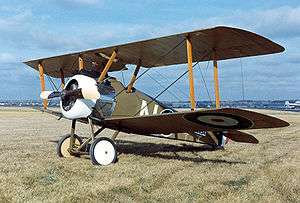Herbert Smith (aircraft designer)
| Herbert Smith | |
|---|---|
| Born |
May 1, 1889 Bradley, North Yorkshire |
| Died | 1977 (aged 88) |
| Nationality | British |
| Occupation | Aircraft designer |
| Known for | Sopwith Camel |
.jpg)
Herbert Smith CRAeS (1889 – 1977) was a British aircraft designer.
Smith was born in Bradley, North Yorkshire, England, on May 1, 1889. As a youth, he attended Keighley Boys Grammar School, in West Yorkshire. Smith subsequently attended Bradford Technical College, graduating with a degree in mechanical engineering in 1907.[1]

Smith started his career with the Yorkshire machine-tool manufacturers Dean, Smith & Grace,[2] then became a draughtsman with Northampton lift manufacturers Smith, Major and Stephens.[1] In March 1914, Smith joined the Sopwith Aviation Company as a draughtsman. Later that year, he became Sopwith's chief engineer.[3] Smith went on to design the Pup, Triplane, Camel, and Snipe. He worked for the Sopwith firm until it dissolved in October 1920.
In February 1921 the Mitsubishi Internal Combustion Engine Manufacturing Company in Nagoya invited Smith, along with several other former Sopwith engineers to assist Mitsubishi in creating an aircraft manufacturing division.[4] After moving to Japan, they designed the 1MT, B1M, 1MF, and 2MR.[4] Smith returned to England in 1924 and retired from the aviation industry.
Notes
References
- Crampton, John. "Herbert Smith--Aircraft Designer." Air Pictorial: Journal of the Air League of the British Empire, Volume 37, 1975.
- Peattie, Mark. Sunburst: The Rise of Japanese Naval Air Power, 1909-1941. Annapolis, MD: US Naval Institute Press, 2001. ISBN 1-55750-432-6.
- Platt, Robin. “Herbert Smith, Aircraft Designer Par Excellence.” Cross & Cockade International, Summer 2012.
- Robertson, Bruce. Sopwith – The Man and His Aircraft. London: Harleyford, 1970. ISBN 0-900435-15-1.